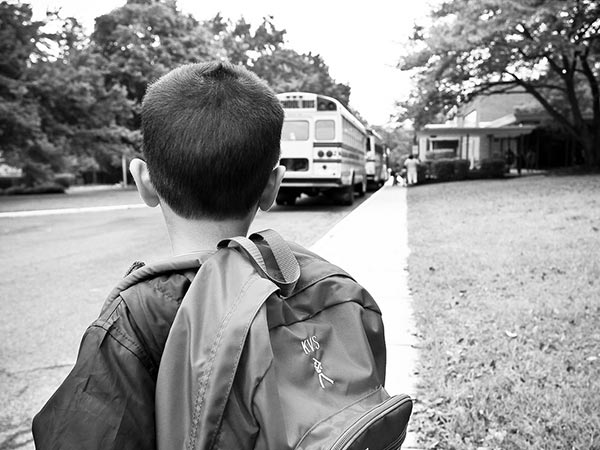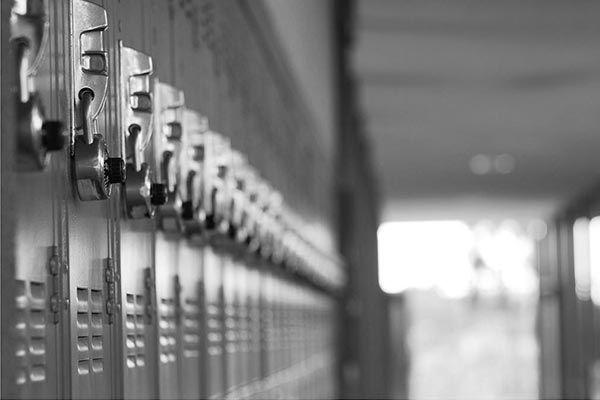Subtotal: $
Checkout-

A School of One
-

On Praying for Your Children
-

The World Is Your Classroom
-

The Good Reader
-

Orchestras of Change
-

The Habit of Lack Is Hell to Break
-

Kindergarten
-

The Given Note
-

Editors’ Picks Issue 19
-

Litanies of Reclamation
-

The Children of Pyongyang
-

How Far Does Forgiveness Reach?
-

A Trio of Lenten Readers
-

Michael and Margaretha Sattler
-

The Blessed Woman of Nazareth
-

New Heaven, New War
-

Born to Us
-

My Fearless Future
-

Covering the Cover: School for Life
-

The Community of Education
-

Readers Respond: Issue 19
-

Family and Friends: Issue 19
-

Verena Arnold
-

Tundra Swans
-

A Debt to Education

What’s the Good of a School?
Helping your child flourish means not putting her first.
By D. L. Mayfield
January 7, 2019
I know every parent says this, but it’s true: my daughter is brilliant. She taught herself to read when she was four. She has always been sensitive, prone to anxiety, her mind always a few steps ahead of every story. When she tested into the gifted and talented program at her school, we weren’t all that surprised.
I was primarily homeschooled, so I was intrigued by the entire process. It raised questions about my values for education – not just for my daughter, but for our country as a whole. According to federal guidelines, all public schools must provide resources to identify and support “gifted” students. The general assumption is that gifted students are bright, deserving of harder classes and more engagement. But this isn’t always the case. As my daughter’s second grade teacher told us, there are differences between “bright” and “gifted” learners – the former tend to be high-achieving performers, while the latter can often struggle in academics.

Photograph by George Becker (public domain)
Giftedness, as some educators are learning to describe it, really is an issue of asynchronous development: a child’s brain might be able to understand and absorb complex math problems, while socially he fails to pick up nonverbal cues and is left out of games. There is also rising awareness of advanced learning capabilities occurring simultaneously with other conditions such as attention deficit hyperactivity disorder, obsessive compulsive disorder, or others – these students are called twice exceptional (2e) learners.
What, exactly, did I want my gifted child to get out of her education?
Here in the United States, where education is seen both as a right and a competition, I find the tension between loving our neighbors and advocating for our own children is exemplified by gifted programs. I started to ask questions: Who gets identified as gifted? Which schools end up getting those coveted extra resources? And what, exactly, did I want my gifted child to get out of her education?
That last question is probably one we should be asking ourselves more. I would say that a good school leaves students feeling safe and cared for, serves all of its students equally, and imparts to its students curiosity about the world – the key to a lifetime of learning. For others, the answer might include challenging academics, a push to become better citizens, or preparation for successful jobs.
And yet, this is not how schools are often measured or discussed. At least in my circle of acquaintance, people often learn about their local public schools from websites that rank them according to standardized test scores. Do such ratings reflect social and emotional intelligence, student involvement, community impact, or a culture of care? They do not; nor do these ratings rely on the witness of teachers, students, and parents – arguably the best experts on how the school is doing.
As educators have proposed, coming up with metrics that better reflect our actual values (including things like teaching environment, civic engagement, resource allocation, and academic progress) could help us identify schools that are truly working for every child in the community.
When Jack Schneider, author of Beyond Test Scores, became frustrated with how his own neighborhood school was rated, he set about researching why this happened. Schneider points out that when we began to view education as a private good instead of a public good, it became a race for the best education. In economics this is called a positional good – your education is only worth something if it’s somehow better than another person’s. Because of this, there is little incentive to put resources into lower-achieving schools, and segregation and inequality persist and thrive.
Schneider then explores measures of success that can’t always be tested. Together with other researchers, educators, and scholars, he is working to change how schools in his state of Massachusetts are analyzed – including how staff, students, and community members view their school as an important part of assessment. In a sense, Schneider and others are advocating that these actual stakeholders know best how a school is serving the community. This type of analysis takes more work, but I believe it is the right step toward ensuring that all schools are places of flourishing for all children.

Photograph by iamdusky (public domain)
By classifying schools as good or bad, failing or desirable, entire neighborhoods have been changed. People with means move into neighborhoods with “good” schools, driving up prices that ensure lower-income families won’t be able to afford to live there. In an unequal system, choice leads to concentrations of lower-income communities that are often left with fewer resources for their schools.
Isn’t the goal that every child should flourish? It seems to be the goal behind the US Department of Education’s mission, “to promote student achievement … by fostering educational excellence and ensuring equal access.” But as I have found in my own state of Oregon, this isn’t reality. While discrimination based on race or income is against the law, upwardly mobile parents have found ways to rig the system in their favor, often under the guise of doing what is best for their own children. In a Christian culture that often encourages people to focus on their families, this practice has been baptized in the name of common sense. Meanwhile, the common good in our own communities has suffered. Public schools in the United States continue to be segregated both by income and race, which results in resources not being equitably allocated to our country’s children.
Programs for giftedness in public schools are one example of this bigger issue. Our local elementary school on the outskirts of Portland has a student population that is 56 percent Hispanic and 20 percent white. Ninety-four percent of students qualify for the free and reduced lunch program, which means they live close to or below the poverty line. It is also incredibly rich in culture, with over twenty-seven languages spoken inside its walls.
Our school of just under five hundred students has eight kids that tested into the gifted program – less than 2 percent of the population. Half of those students are white. Overall, the rates of students being identified as gifted are low and, while the program director tells me that they are actively working for more equity in those numbers, they don’t yet match the school’s racial makeup. The reason seems to be that neither teachers nor standardized testing do well at identifying the wide variety of gifted learners, especially those from different cultural or ethnic backgrounds.

Photograph by Kristine May (public domain)
By contrast, one of the “best” school districts in the state has vastly different numbers. One highly rated elementary school is 88 percent white, has less than 8 percent of students on free and reduced lunch, and fully 5 percent of the student body tested into the gifted program. Are the students at this school inherently smarter because more are white and fewer are poor? Or is something else going on here?
These kinds of disparities affect students around the country. In a New York Times article on the gifted program in Charlottesville, Virginia, journalists argue that these programs have been used to re-segregate the school system in many parts of the country. According to federal data, in 1984 only 11 percent of Charlottesville’s white students qualified as gifted. By 2003, about a third of white students qualified – and currently white students in Charlottesville are six times as likely to be in advanced courses as black students.
Our local school mirrors what Jesus tells us of the kingdom of God.
This is just one picture of how race affects the public education system. Since the 1954 Brown v. Board of Education ruling there have been many ways that white parents have avoided truly integrating schools. Sadly, many Christians have been involved in this, with private Christian schools and homeschooling movements directly contributing to a new kind of segregation – one based not on overtly racist rhetoric, but predicated on the idea of the right to personal choice.
School choice has also been a vehicle of equality, however. As Nicole Baker Fulgham points out in Educating All God’s Children, African American pastors, along with increasing numbers of Latino and Hispanic clergy, have pushed for alternatives for children in habitually under-performing communities – either by starting their own schools or by requesting vouchers for charter and private schools. Baker observes that while she recognizes the way Christians in non-white majority neighborhoods have often fought for justice in the school system, she has yet to see a large-scale, coordinated push for educational justice that would help all children.
Overall, it might be time to pay attention to the impact of prioritizing school choice, which overwhelmingly benefits the privileged. The free-market approach to education has led to higher concentrations of low-income children in local schools. It is re-segregating the system.
What is the right relationship to educational choice for the Christian? It’s complicated, and I often think about what Paul was trying to communicate in Galatians: it is for freedom that Christ has set us free. “For you were called to freedom, brothers. Only do not use your freedom as an opportunity for the flesh, but through love serve one another. For the whole law is fulfilled in one word: ‘you shall love your neighbor as yourself’” (5:1, 13–14). Paul, a shrewd observer of humanity, anticipated that the allure of freedom can sometimes result in our selfish natures seeking the best for ourselves, meanwhile forgetting our responsibility to our neighbors.
How do we love and educate our precious, unique, smart children in a world driven by outward measures of success and a fear of scarcity of resources? This continues to be a question for my family. I am still surprised by how easy it is to slip into the mindset of wanting what is best for my child, perhaps even at the expense of others.
Although my daughter was identified as gifted last year, there is not a lot that her school offers in the way of enrichment for such kids. Last year it depended upon the goodness of a teacher willing to forgo lunch once a week to provide programming. This year, there have been no meetings, no extra work, and only a vague action plan to encourage my daughter to read a wider variety of books. As her parent, I feel torn, driven by a desire to see her capabilities challenged. But I have slowly been interrogating my motives and my fears. In the underpaid and understaffed world of Title I schools, advocating for extra resources for less than 2 percent of the population strikes me as immoral – or at least, part of the problem.
I easily slip into the mindset of wanting what is best for my child – even at the expense of others.
Instead, working together with other parents and teachers, we continue to build resources that will benefit a wider range of students: bringing back the Scholastic book fair, starting a team of kids to compete in a local reading program, pushing to have a mural painted outside the school to celebrate the joyful diversity inside its walls. Recently a parent leadership group has formed, and parents from a wide variety of backgrounds are raising their voices and ask for improvements – including an increase in academic work that challenges their children. Together we are making the school continue to work for everyone – as racial and socio-economic integration has been consistently shown to do.
It’s hard to overestimate how strongly the desire for success shapes our society. But the end result is the same: resources are consolidated, snatched up, and segregated. Now more than ever, schools with high rates of poverty are abandoned in favor of better test scores. And all of us have a part to play in this. As people of faith, do we want to pursue the “best” for our children? Or when Paul says, “knowledge puffs up, but true love builds up,” do we take him at his word?
My daughter loves her school. Her character – who she is at her core – is being built up not just by her classmates (many of them refugees and immigrants from places we see constantly in the news headlines) but by teachers, staff, parents, and community members. She, unlike me, is growing up with an awareness of how to navigate real differences in religion, culture, race, and academics, and she is being given the gift of being in the minority (which could come in handy in the future, as the United States continues to grow more diverse).

Photograph by Katelyn Tam (public domain)
And our local school, which from some perspectives looks like it is lacking in resources or pathways for gifted students, does something even more valuable: it is a sanctuary, one of the few spaces in our city and community that is committed to helping everyone, no matter their situation. Entering its doors, I sometimes almost feel like it is a sacred space; it is one of the few places where I have seen any child welcomed – no matter her ethnic and socio-economic identity, her cognitive or physical ability. This is a place that mirrors what Jesus tells us of the kingdom of God, where the people our society ignores are treated as valuable, and as blessed.
I think of my daughter, and even myself, in light of words like “giftedness” or “talent” and how they orient me in the direction of individualism and fear, in the direction of always having the best. This is the pursuit of the kind of knowledge that Paul says “puffs up” – distancing us from our neighbors and leading to harm and inequality. This is why I agree with the experts that giftedness is better understood as asynchronous development – when parts of our mind, or perhaps even our socio-emotional intelligence, advance faster than other parts. All of us have areas where we need to grow, where we need to be built up. All of us are hindered in our quest to better love God by loving our neighbors – perhaps by fear, or selfishness, or an idolization of success.
In the end, I don’t want what is best for my daughter according to our society. I want what is best for all of God’s kids, which is why I continue to long for the day when we orient ourselves accordingly, and choose to put resources into the places that have deliberately been ignored. Real education builds up – and it always starts at the very bottom, because that is where we learn how to love and be loved by our neighbors.
Already a subscriber? Sign in
Try 3 months of unlimited access. Start your FREE TRIAL today. Cancel anytime.




































Hosanna
As a young mother who is only beginning to consider the various factors and decisions entailed in my child's education, I found this article incredibly convicting, thoughtful, and nuanced. Thank you.
Bonnie senn
I don’t agree with all of this. We do have a responsibility to community. We can have schools in a community that are like minded beliefs, however in a public school system of today; we cannot protect our children.Our first calling it to love God first and others second. Our first calling from God is to care for our children and protect them. Their are ways to be involved in community without going to public schools.
Athletic Bilbao Left Back
As an immigrant, I would do everything to ensure that my child gets the best education; indeed, it is a peak sign of white racial privilege for one to send one's child to a Title I school so as to offer a riposte to a narrow reading of the American Dream, American material success; it is also a white racial benchmark privilege to steep oneself in a racially and culturally diverse atmosphere so as to make public proclamations. At the end of the day, Mayfield's clearly highly intelligent daughter will succeed in life, despite her mother's virtue signalling; the daughter has racial privilege; more importantly and far more importantly, she is intelligent and has already shown the tools to navigate the world. The child deserves every right to materially and academically succeed in the world so that she can be an instrument and light of God in a broken but becoming unbroken world.
rich anthony abundant
Thank you.
Michele
I grew up in San Francisco, where these issues have been at the forefront of parental decisions and legal battles for all of my life. I remember the diversity of my public elementary school before busing ended and the less-diverse campus we had after busing ended. In middle school, I experienced both the regular classrooms, with the multitude of disciplinary problems that kept us from getting to the curriculum (and the gross ignorance of some of the teachers), and the "gifted" classrooms, which were a night/day difference in terms of learning and engagement. I then went to a public "gifted" high school - one that faced decades of legal battles because of its diversity (about 15% white). Ironically, given this author's background, we opted to homeschool. We lived in a very white community when the kids were old enough to start school and found more diversity in the homeschool community. I continue to value that diversity (race, religion, economics, perspective) as we continue our homeschooling journey. There are many excellent points in this article. It raises so many good questions about giftedness, individualism, competition, race, economics, community, diversity, education, and more. In particular, I appreciate the exploration of the accepted value that making choices that benefit your own child over others is always an absolute. I think that a more ethical perspective is more nuanced, at an individual and community level, allowing parents to look to both their child's needs and the needs of the community to which they belong. Gifted/bright children shouldn't have their capabilities squashed, but the ideal situation can't be one that perpetuates segregation either.
MICHAEL NACRELLI
There's much more to the issue of school choice than Mayfield suggests. Groups such as the Center for Public Justice have explored the subject in much greater depth. (I'd provide some links, but I don't think that's allowed here.)
Leslie Jogi
Thank you for this article. I was involved in Christian Education in Zimbabwe and became more and more uncomfortable with schools whose goals were/are exactly those of the public system - the winner takes it all. This is such a sadness and a huge missed opportunity for children who attend those schools in terms of learning to value "the other", to love their neighbour rather than paying lip service to its deep call to live the Gospel. Sincerely Leslie
Dan Russ
"A multi-track system, with children grouped according to their assumed ability to learn, establishes a class structure defined in childhood, a slaughter of the innocents, so to speak. In the same manner, too, a vocational track in secondary schools reinforces cultural differences. It seems to the privileged members of society s kind go concerned expedient to provide a ready path for sustenance and a "way up" to lesser abilities and limited ambitions; but such an attitude is an unwarranted condescension and an unrecognized intention of preserving the status quo. In reality, vocationalism is a preparation for obsolescence, a harbinger of frustration. The public is ill-served, both economically and culturally, by such a separation of young minds into workers and thinkers, and democracy is thereby rendered a virtual impossibility." Donald Cowan, Unbinding Prometheus: Education for the Coming Age, p. 96.